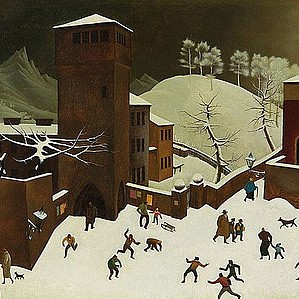TRUDE WAEHNER (Vienna 1900 - 1979 Vienna) Bruno Walter conducts Mahler
Lot 80
Categories
Estimate:
EUR€200 - EUR€300
$215.05 - $322.58
Absentee vs Live bid
Two ways to bid:
- Leave a max absentee bid and the platform will bid on your behalf up to your maximum bid during the live auction.
- Bid live during the auction and your bids will be submitted real-time to the auctioneer.
Bid Increments
| Price | Bid Increment |
|---|---|
| EUR€0 | EUR€10 |
| EUR€100 | EUR€50 |
| EUR€700 | EUR€100 |
| EUR€1,000 | EUR€200 |
| EUR€3,000 | EUR€300 |
| EUR€3,600 | EUR€400 |
| EUR€4,000 | EUR€500 |
| EUR€7,000 | EUR€1,000 |
| EUR€16,000 | EUR€2,000 |
| EUR€30,000 | EUR€3,000 |
| EUR€36,000 | EUR€4,000 |
| EUR€40,000 | EUR€5,000 |
About Auction
By Widder Auctions
May 19, 2022
Set Reminder
2022-05-19 11:00:00
2022-05-19 11:00:00
America/New_York
Bidsquare
Bidsquare : Masterpieces
https://www.bidsquare.com/auctions/widder-auctions/masterpieces-9287
Masterpieces of classical modernism by Austrian and international artists coming up for auction in Vienna on May 19th Widder Auctions office@widderauktionen.com
Masterpieces of classical modernism by Austrian and international artists coming up for auction in Vienna on May 19th Widder Auctions office@widderauktionen.com
- Lot Description
TRUDE WAEHNER*
(Vienna 1900 - 1979 Vienna)
Bruno Walter conducts Mahler
woodcut/paper, 27,6 x 18 cm, sheet size 53,6 x 33cm
signed Waehner and inscribed Bruno Walter dirige Mahler prove d'Autore 1973 dal ciclo "Fare e Sentire Musica"
Provenance: estate of the artist, Gustav Szekely collection, Fine Arts Widder
ESTIMATE °€ 200 - 300
Austrian painter of the 20th century. Studied for two years at the Academy of Music, then at the Vienna School of Applied Arts with Oskar Strnad and Josef Frank. From 1928 on the recommendation of Walter Gropius and mediation of Josef Frank at the Bauhaus in Dessau in the class of Paul Klee. Attended courses by Wassily Kandinsky. Went to Berlin in 1932, contact with Bruno Cassirer and contact with Bert Brecht, Otto Dix, Klaus and Erika Mann. In 1933 she went back to Vienna and and fled after the Anschluss in 1938 via Switzerland, France, England to the USA. Her studio in Buchfeldgasse in Vienna was taken over by Heimito von Doderer, and Albert Paris Gütersloh lived there as a lodger. Always critical of anti-Semitism and fascism, her second husband was of Jewish origin. In the U.S. she taught art at Sarah Lawrence College in New York and at the Moravian Seminary and College for Women in Pennsylvania. After the war, she lived in Vienna, southern Sicily (Dieulefit) and Venice. 1937 personale at the Würthle Gallery, member of the Austrian Werkbund. Began to make more woodcuts in Venice, many portraits and portraits of musicians, cellists, composers and conductors. Pablo Casals was a Spanish, cellist, composer and conductor.
Along with Helene Funke and Margarete Berger-Hamerschlag, Trude Waehner, who came from an upper-class Viennese family, is one of the influential, long-overlooked Viennese artists who had to emigrate and thus ran the risk of being disconnected from the art scene. From 1918 on, she studied at the Vienna School of Arts and Crafts, only to get to the Bauhaus in Dessau in 1928 through the mediation of Josef Frank. There she entered Paul Klee's painting class and also took courses with Wassily Kandinsky. When the famous Berlin art dealer Paul Cassirer offered her an exhibition in 1933, this was thwarted by the political upheaval and her Berlin studio was destroyed by the Gestapo. As a result, the artist not only clearly pointed out the dangers of fascism in her works, but also actively helped with the production of identity papers and supported others fleeing Vienna. As an attentive observer of social and political developments, Waehner designed anti-fascist graphics as early as the late 1920s. From the 1930s onwards, her artistic work repeatedly referred to the political situation, from which she unequivocally distanced herself. The artist, who had returned to Austria in 1933, was prevented from exhibiting due to her political commitment and her anti-fascist views. In 1938 she emigrated to New York. As a result of networking with other emigrants and the contacts she had made with Americans in recent years, she soon found a living through private painting lessons. With letters of recommendation from Josef Frank, Hans Tietze and Oskar Kokoschka, Waehner also received two teaching positions at schools in the USA and began to work in the field of art psychology. Her artistic work in these years was mainly characterized by portraits and cityscapes.
PLEASE NOTE:
The purchase price consists of the highest bid plus the buyer's premium, sales tax and, if applicable, the fee of artists resale rights. In the case of normal taxation (marked ° in the catalog), a premium of 24% is added to the highest bid. The mandatory sales tax of 13% is added to the sum of the highest bid and the buyer's premium. The buyer's premium amounts to 28% in case of differential taxation. The sales tax is included in the differential taxation. - Shipping Info
-
Shipping
We will send you the invoice shortly after the auction. As soon as we have recieved the amount, the art can be picked up at Johannesgasse 9-13, 1010 Vienna. Please note that the buyer is responsible for pick-up and shipping of the lot.
Should you wish to ship your items, please contact: Mailboxes Email: oper@mbe-co.at Tel: 01 5128855
Please note that storage fees may apply, should the pieces not be picked up within 14 days after invoicing for domestic and 28 days for international transportation.
Our team will be happy to assist you with any further information at office@widderauktionen.com or at 0043 676 555 66 10.
-
- Buyer's Premium



 EUR
EUR CAD
CAD AUD
AUD GBP
GBP MXN
MXN HKD
HKD CNY
CNY MYR
MYR SEK
SEK SGD
SGD CHF
CHF THB
THB











